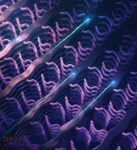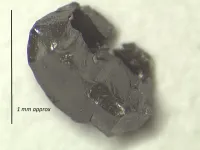Epsilon variant mutations contribute to COVID immune evasion
Studies reveal unprecedented mechanism behind loss of antibody neutralization against this pandemic coronavirus variant of concern
2021-07-06
(Press-News.org) Three mutations in the Epsilon coronavirus spike protein dampen the neutralizing potency of antibodies induced by current vaccines or past COVID infections.
The mutations give this coronavirus variant of concern a means to totally evade specific monoclonal antibodies used in clinics and reduce the effectiveness of antibodies from the plasma of vaccinated people.
To better understand the exact immune escape strategies at work here, the scientists visualized this variant's infection machinery to see what is different from the original configuration of the pandemic coronavirus, and what the implications of these changes are.
The international project was led by David Veesler's lab in the Department of Biochemistry at the University of Washington in Seattle and by Luca Piccoli and Davide Corti of Vir Biotechnology.
For several years, the Veesler lab and its collaborators have been exploring the molecular conformation and infection mechanics of SARS-like coronaviruses. They also examine how antibodies attempt to block infection mechanisms, and how variants come up with new dodges.
Their latest data shows that the Epsilon variant "relies on an indirect and unusual neutralization-escape strategy," according to the researchers.
Their findings are published as a First Release paper in Science.
A molecular clock analysis timed the emergence of the precursor to the Epsilon variant to May of 2020 in California. By summer of 2020 it had diverged into its B.1.427/B.1.429 lineages. COVID cases from the variant increased quickly, and the variant soon became widespread in the United States. It has now been reported in at least 34 other countries.
To learn more about the characteristics of the Epsilon variant, the researchers tested the resilience against the Epsilon variant of plasma from people who were exposed the virus, as well as vaccinated people. The neutralizing potency of the plasma against the Epsilon variant of concern was reduced about 2 to 3.5 fold.
Like the original SARS-CoV-2, the variant infects target cells through its spike glycoprotein - the structure that crowns the surface of the virus. The researchers found that the Epsilon mutations were responsible for rearrangements in critical areas of the spike glycoprotein; electron cryomicroscopy studies showed structural changes in these areas.
Visualizing these mutations helps explain why antibodies had difficulty binding to the spike glycoprotein.
One of the three mutations in the Epsilon variant affected the receptor binding domain on the spike glycoprotein. This mutation reduced the neutralizing activity of 14 out of 34 neutralizing antibodies specific to that domain, including clinical stage antibodies.
The other two of the three mutations in the variant affected the N-terminal domain on the spike glycoprotein. The researchers used mass spectrometry and structural analysis to find that a part of the coronavirus N-terminal domain was remodeled by these mutations.
The signal peptide cleavage site was shifted in the NTD antigenic supersite, and a new disulphide bond was formed. This resulted in a total loss of neutralization by 10 out of 10 antibodies tested specific to the N-terminal domain in the spike glycoprotein.
The scientist believed that uncovering mechanisms of immune evasion, such as this newfound mechanism based on signal peptide modification, is as important as variant surveillance through RNA sequencing. Together, they note, such efforts could help to successfully counter the ongoing pandemic.
INFORMATION:
The lead scientists on this project were Matthew McCallum and Alexandra C. Walls of the UW School of Medicine Department of Biochemistry; Jessica Bassi and Anna de Marco of Humabs Biomed; and Alex Chen of Vir Biotechnology.
This study was supported by the National Institute of Allergy and Infectious Diseases at the National institutes of Health, Pew Biomedical Scholars Award, Investigators in the Pathogenesis of Infectious Disease Awards from the Burroughs Wellcome Fund, Fast Grants, Natural Sciences and Engineering Research Council of Canada, and Pasteur Institute.
[Attachments] See images for this press release:

ELSE PRESS RELEASES FROM THIS DATE:
2021-07-06
In a retrospective, multi-centre cohort study conducted by researchers from Nanjing University, Huazhong University of Science and Technology, Jinling Hospital and the Second Hospital of Nanjing, a microRNA-like small RNA encoded by SARS-CoV-2 was identified in the serum of COVID-19 patients, which can be developed as a non-invasive biomarker for stratification of severe patients from mild/moderate ones and for identification of high-risk individuals before clinical manifestation of severe symptoms. This biomarker ensures proper allocation of patients to different ...
2021-07-06
A research team, led by Professor Dai-Sik Kim in the Department of Physics at UNIST has developed a new technique of predefining the crack pattern on a flexible substrate by a sequential deposition of metallic layers which leads to a formation of a "zero-nanometer gap, or a "zerogap," between the adjacent lateral patterns.
These gaps, according to the research team, readily open and recover with gentle bending and relaxing of the flexible substrate, precisely along the rims of the pre-patterns of centimeter lengths. Furthermore, in a prototypical pattern of densely packed slit arrays, these gaps serve as antennas achieving transparency for polarizations perpendicular to the length of the gap when opened ...
2021-07-06
Chemical elements make up pretty much everything in the physical world. As of 2016, we know of 118 elements, all of which can be found categorized in the famous periodic table that hangs in every chemistry lab and classroom.
Each element in the periodic table appears as a one-, two-letter abbreviation (e.g. O for oxygen, Al for aluminum) along with its atomic number, which shows how many protons there are in the element's nucleus. The number of protons is enormously important, as it also determines how many electrons orbit the nucleus, which essentially makes the element what it is and gives it its chemical properties. In short, the atomic number is an element's ID card.
The periodic table ...
2021-07-06
A new organic (carbon-based) semiconducting material has been developed that outperforms existing options for building the next generation of biosensors. An international research team led by KAUST is the first to overcome some critical challenges in developing this polymer.
Much research effort is currently expended into novel types of biosensors that interact directly with the body to detect key biochemicals and serve as indicators of health and disease.
"For a sensor to be compatible with the body, we need to use soft organic materials with ...
2021-07-06
Networks of ground-based sensors paired with airborne drones could give firefighters a critical edge when battling wildfires, KAUST researchers have found. The sensor/unmanned aerial vehicle (UAV) network could significantly shorten the time taken to detect a wildfire, giving firefighters a better chance to contain the fire before it grows too large to control.
Wildfire detection is currently performed mainly by satellite imaging and remote cameras, but these technologies can be impeded by cloudy weather and fires can grow to a considerable size before they are spotted. With the recent significant global ...
2021-07-06
The surprising results of a decade-long investigation by Alessandro Vezzosi and Agnese Sabato provide a strong basis for advancing a project researching Leonardo da Vinci's DNA.
Their extensive study, published by the journal "Human Evolution" (Pontecorboli Editore, Florence), documents with new certainty the continuous male line, from father to son, of the Da Vinci family (later Vinci), from progenitor Michele (born 1331) to grandson Leonardo (6th generation, born 1452) through to today -- 21 generations in all, including five family branches -- and identifies 14 living descendants.
The work fills gaps and corrects errors in previous genealogical research into Leonardo's family, while ...
2021-07-06
A new study shows how urbanisation has influenced anthropogenic CO2 and air pollutant emissions across all world regions, by making use of the latest developments in the Emissions Database for Global Atmospheric Research (EDGAR, https://edgar.jrc.ec.europa.eu/) developed by the Joint Research Centre of the European Commission. The results show that by 2015 urban centres were the source of a third of global anthropogenic greenhouse gases, and the majority of air pollutant emissions.
The authors, from institutions in France and Italy, used the EDGAR database to provide a country-to-global ...
2021-07-06
Researchers at Karolinska Institutet in Sweden publish new findings in the journal Cancer Discovery showing how pharmacological activation of the protein p53 boosts the immune response against tumours. The results can be of significance to the development of new combination therapies that will give more cancer patients access to immunotherapy.
Given its ability to react to damage to cellular DNA and the key part it is thought to play in preventing tumour growth, the protein p53 has been dubbed the "guardian of the genome". Half of all tumours have mutations in the gene that codes for the protein, and in many other tumours, p53 is disabled by another protein, MDM2.
It has long been known ...
2021-07-06
Scientists have taken the first steps in developing a new method of identifying the movements of criminals using chemical analysis of soil and dust found on equipment, clothing and cars. The locating system allows police or security services to match soil remnants found on personal items to regional soil samples, to either implicate or eliminate presence at a crime scene. The work is presented as a Keynote Lecture at the Goldschmidt Geochemistry Conference, after recent publication.
Dr Patrice de Caritat, Principal Research Scientist at Geoscience Australia, Australia's public sector geoscience organisation, said:
"We've ...
2021-07-06
A unique study of ancient diamonds has shown that the basic chemical composition of the Earth's atmosphere which makes it suitable for life's explosion of diversity was laid down at least 2.7 billion years ago. Volatile gases conserved in diamonds found in ancient rocks were present in similar proportions to those found in today's mantle, which in turn indicates that there has been no fundamental change in the proportions of volatiles in the atmosphere over the last few billion years. This shows that one of the basic conditions necessary to support life, the presence of life-giving elements in sufficient quantity, appeared soon after Earth formed, and has remained fairly constant ever since.
Presenting the work at the Goldschmidt ...
LAST 30 PRESS RELEASES:
[Press-News.org] Epsilon variant mutations contribute to COVID immune evasion
Studies reveal unprecedented mechanism behind loss of antibody neutralization against this pandemic coronavirus variant of concern






